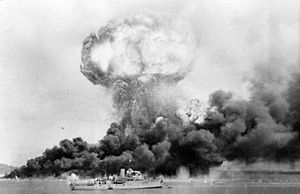Bombing of Darwin
| Bombing of Darwin | |||||||
|---|---|---|---|---|---|---|---|
| Part of World War II, Pacific War | |||||||
 The explosion of an oil storage tank and clouds of smoke from other oil tanks hit during the first Japanese air raid on Australia's mainland, at Darwin on 19 February 1942. In the foreground is HMAS Deloraine, which escaped damage. |
|||||||
|
|||||||
| Belligerents | |||||||
|
|
|
||||||
| Commanders and leaders | |||||||
|
|
|||||||
| Strength | |||||||
| 31 aircraft 18 A/A Guns 1 Destroyer 1 Seaplane Tender 2 Sloops 4 Minesweeper/Corvettes 4 Boom Defence Vessels 9 Merchant ships/Transports 1 Hospital Ship 23 Auxiliary vessels 12 Pearling luggers |
242 aircraft 4 Aircraft Carriers 2 Heavy cruisers 1 Light Cruiser 7 Destroyers 3 Submarines |
||||||
| Casualties and losses | |||||||
| 236 killed 300–400 wounded 30 aircraft destroyed 11 vessels sunk 3 vessels grounded 25 ships damaged |
2 killed 1 POW 4 aircraft destroyed |
||||||
The Bombing of Darwin, also known as the Battle of Darwin, on 19 February 1942 was the largest single attack ever mounted by a foreign power on Australia. On that day, 242 Japanese aircraft, in two separate raids, attacked the town, ships in Darwin's harbour and the town's two airfields in an attempt to prevent the Allies from using them as bases to contest the invasions of Timor and Java. The town was only lightly defended and the Japanese inflicted heavy losses upon the Allied forces at little cost to themselves. The urban areas of Darwin also suffered some damage from the raids and there were a number of civilian casualties.
The two Japanese air raids were the first, and largest, of more than 100 air raids against Australia during 1942–43.
In 1942, Darwin was a small town with limited civil and military infrastructure. Due to its strategic position in northern Australia, the Royal Australian Navy (RAN) and Royal Australian Air Force (RAAF) had constructed bases near the town in the 1930s and the early years of World War II. Darwin's pre-war population was 5,800.
As early as August 1941 Darwin had been a key in the South Pacific air ferry route designed to avoid routes through the Japanese mandate in the central Pacific for bomber reinforcement of the Philippines. The first flight to use the route occurred when nine B-17D bombers of the 14th Bombardment Squadron (H) left Hawaii on 5 September and passed through Darwin 10–12 September. By October 1941 plans were underway to position fuel and supplies with two ships, including USAT Don Esteban, being chartered and actively engaged in that purpose when war came. By November 1941 Australia had agreed to allow the establishment of training bases, maintenance facilities, munitions storage, communications, and improvement of airfields, including at Darwin, to meet the needs of the B-17 bombers in Australia.
...
Wikipedia
